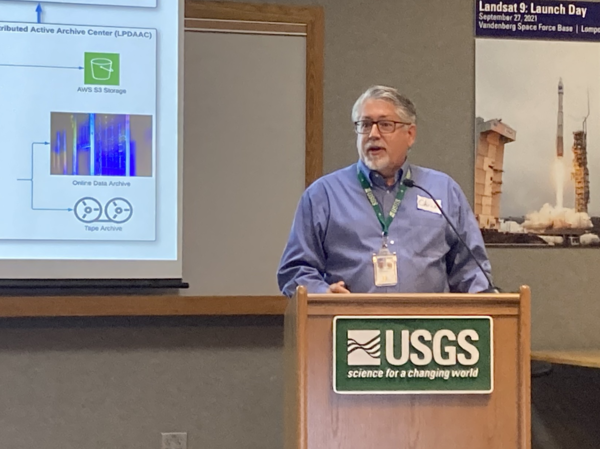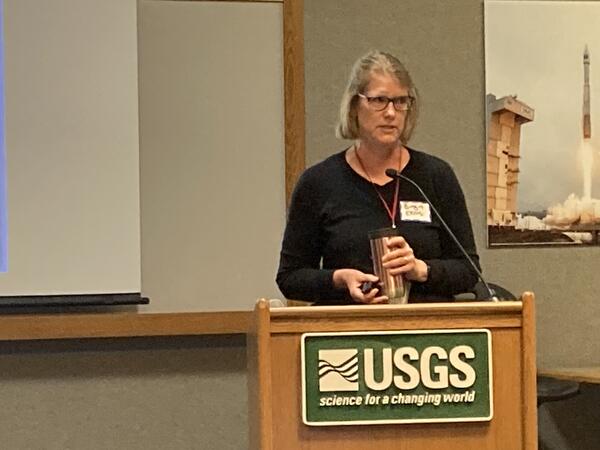ECOSTRESS, or ECOsystem Spaceborne Thermal Radiometer Experiment on Space Station, data provides variables related to plant water stress, including evapotranspiration, evaporative stress index and water use efficiency. The NASA Land Processes Distributed Active Archive Center (LP DAAC) at EROS provides storage and distribution of ECOSTRESS data.
NASA Archive Evolves While Still Calling USGS Home
The LP DAAC and EROS both benefit from their connections
A U.S. Geological Survey (USGS) building in rural South Dakota might seem like an unusual setting for people from across the country to gather and offer input for a NASA endeavor. But the visit to the NASA Land Processes Distributed Active Archive Center (LP DAAC) there highlighted a number of ways the USGS intertwines with NASA to produce and support remote sensing data.
NASA established the LP DAAC at the USGS Earth Resources Observation and Science (EROS) Center more than three decades ago to manage some data from its Earth Observing System (EOS). But NASA’s roots at EROS run even deeper: The center began as NASA’s archive partner in the 52-year-old Landsat satellite program.
About 40 USGS EROS federal and contract employees provide the workforce for the LP DAAC, which archives NASA-funded land data from sensors located on satellites and the International Space Station. Some LP DAAC employees first worked at other positions at EROS, which has expanded from its initial archive purpose into Landsat satellite operations and science applications. Similarly, some previous LP DAAC employees have shifted into other departments at EROS.
Today, data from both the LP DAAC and USGS EROS archives are used by scientists in government agencies, universities and other organizations around the world to monitor and make decisions about topics that range from agriculture and wildfires to urban planning, flooding and hotspot detections.
The recent LP DAAC Annual User Working Group (UWG) Meeting at EROS spotlighted just a few of the many uses for remote sensing data. The LP DAAC UWG is made up of 15 representatives in various career stages at universities, government agencies and commercial endeavors whose work involves using LP DAAC data, tools and resources.
The data come from well-known sensors such as the Moderate Resolution Imaging Spectroradiometer (MODIS) and newer sensors like the Global Ecosystem Dynamics Investigation (GEDI). The LP DAAC also archives the Harmonized Landsat Sentinel-2 (HLS) data, produced from a combination of data from Landsat satellites and European Sentinel-2 satellites.
Some LP DAAC users also use EROS-generated data—commonly Landsat, but also science products like the National Land Cover Database (NLCD), now called Annual NLCD; LANDFIRE (Landscape Fire and Resource Management Planning Tools); and Monitoring Trends in Burn Severity (MTBS).
‘Tons of Connections’ Between LP DAAC Users and EROS
The User Working Group was designed to help the LP DAAC learn more about current and future user needs and to collect feedback on how to better support user communities. The working group learned, too—from updates about changes at the LP DAAC and NASA’s 11 other Distributed Active Archive Centers around the country to status reports about the LP DAAC’s active sensors.
They also heard about Landsat updates and were given an overview of the science work at EROS. EROS employees were invited to attend as well to become more familiar with the LP DAAC.
“Hosting at EROS gives us a unique opportunity to kind of expand our User Working Group, because you’ve got the USGS science projects that are also users of LP DAAC data. There’s tons of connections. And then it’s kind of a two-way street because I’ve also got UWG members that are using LANDFIRE data and a lot using Landsat data,” said USGS LP DAAC Project Scientist Cole Krehbiel.
The User Working Group members who attended in person learned more about the EROS archive (below left) firsthand as they were led on a basement tour showing aisles and aisles of shelves loaded with older media containing Landsat and aerial imagery. “It’s funny that the basement is always everyone’s favorite, I think, and seeing those old rolls of film,” Krehbiel said.
In technological contrast, they also viewed supercomputers, available for use by USGS and other Department of Interior scientists, in a climate-controlled computer room at EROS (below right). The computer room also contains several storage racks of LP DAAC data—at least for now.
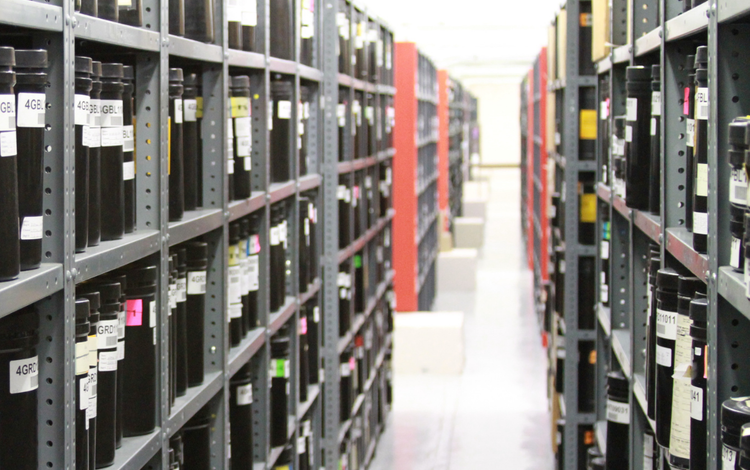
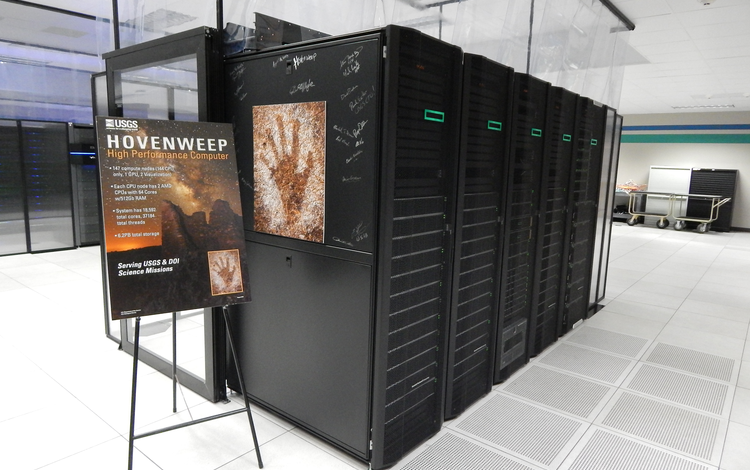
Updates on LP DAAC Data Access Efforts
One LP DAAC update that the User Working Group heard about will affect those EROS computer room racks.
The LP DAAC has been in the process of moving its archive data into the commercial cloud environment for several years so it can be more interoperable, or more easily used in combination with other datasets by scientists. “Datasets are important on their own and stand alone. But they’re better together,” said Chris Torbert, USGS Project Manager for the LP DAAC.
The vast majority of the LP DAAC data that users work with has now been moved to the cloud, the User Working Group was informed, and the LP DAAC will reduce its physical storage footprint at EROS within a year. Still taking up room at EROS for a couple of years will be data from the Advanced Spaceborne Thermal Emission and Reflection Radiometer (ASTER) sensor, which launched in 1999. At the conclusion of a processing effort to create a collection in the cloud of all the ASTER data, that data will be removed physically from EROS, too.
Another update provided to the User Working Group included the LP DAAC’s web presence, which soon will shift from an individual website managed by the USGS to a unified NASA website with the other DAACs. LP DAAC data is accessed through the LP DAAC-developed AppEEARS (Application for Extracting and Exploring Analysis Ready Samples) tool, which serves several other DAACs, too. AppEEARS also currently offers Landsat U.S. Analysis Ready Data (ARD) Surface Reflectance products; integrating those data into AppEEARS was a recommendation from the UWG and a collaborative effort between USGS EROS and the LP DAAC.
AppEEARS provides access, processing and visualization of popular LP DAAC data all in one spot. The LP DAAC wants to explore adding other EROS data products, in addition to Landsat ARD, to AppEEARS for the convenience of its user community using multiple datasets. At the top of the wish list from the UWG was the Annual NLCD products, which the LP DAAC plans to integrate into AppEEARS this year.
EROS Scientist Joins User Working Group
Among the LP DAAC User Working Group’s newest members is EROS’ own Birgit Peterson, a USGS supervisory geographer and the fire science team lead in the Integrated Science and Applications Branch. Peterson uses GEDI data that’s stored in the LP DAAC to get a three-dimensional view of vegetation that can act as fuel for fires and help indicate how a fire would behave in a forest, for example.
Attending the LP DAAC meeting was eye-opening for Peterson, who had given little thought to how the data she downloaded and used became available. Now, she realizes, “there’s a whole science behind it. There’s a whole technology. It makes me want to go out and try different ways to get at some of the data that were talked about.”
Times have changed for the better, she said. “The level of thought that is being put into how we get data out there, just comparing back to 10, 15, close to 20 years ago, has improved so dramatically.”
Peterson hopes to not only represent her own project interests on the User Working Group, but also help represent the perspective of scientists she knows who, with severely limited time, need remote sensing data to be easy to access and use.
“Birgit was an extremely good candidate with her experience with the LANDFIRE program and also wildfire management, fire ecology and those sorts of things,” Krehbiel said. “We were definitely interested in bringing someone into the User Working Group to represent EROS because it is such a huge user community.”
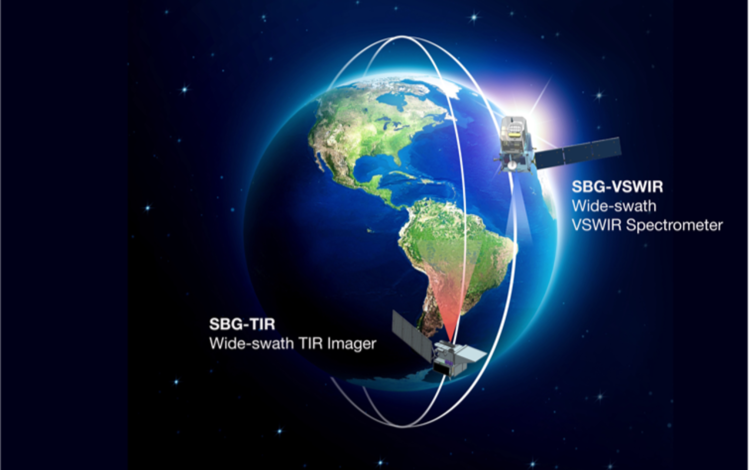
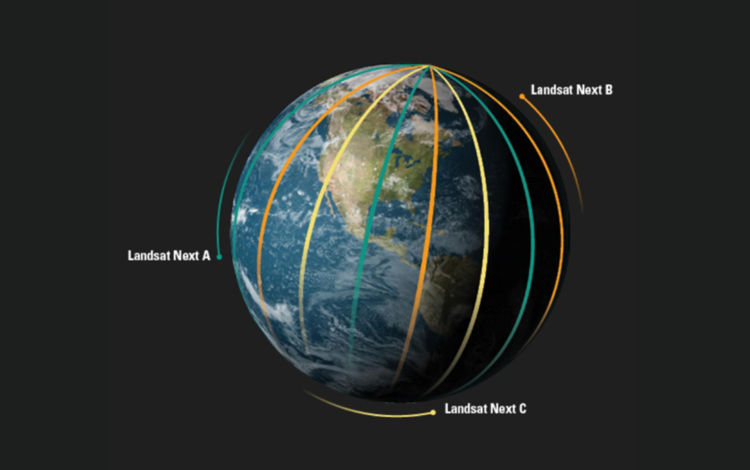
Big Developments Expected for Data Management at EROS
Both the LP DAAC and USGS archive at EROS are looking forward to separate planned Earth observation missions that would significantly expand their data management work in coming years.
The Surface Biology and Geology (SBG) mission is building a new satellite with aspirations for a second, each collecting different data. “I would say, for 30 years, by and large, the LP DAAC has been the MODIS and ASTER DAAC. That’s really been our identity,” Torbert said. “In the future, it’s SBG.”
Meanwhile, the next iteration of Landsat satellites, labeled Landsat Next, is planned to be a constellation of three satellites offering more frequent revisit times around the Earth than previous Landsat satellites. Landsat Next is expected to collect about 20 times the amount of data collected by its predecessor, Landsat 9, which is currently orbiting with Landsat 8.
“To have Landsat Next and SBG both be managed at USGS EROS is a huge accomplishment, and we should be very proud of our center for that,” Krehbiel said.
Get Our News
These items are in the RSS feed format (Really Simple Syndication) based on categories such as topics, locations, and more. You can install and RSS reader browser extension, software, or use a third-party service to receive immediate news updates depending on the feed that you have added. If you click the feed links below, they may look strange because they are simply XML code. An RSS reader can easily read this code and push out a notification to you when something new is posted to our site.




